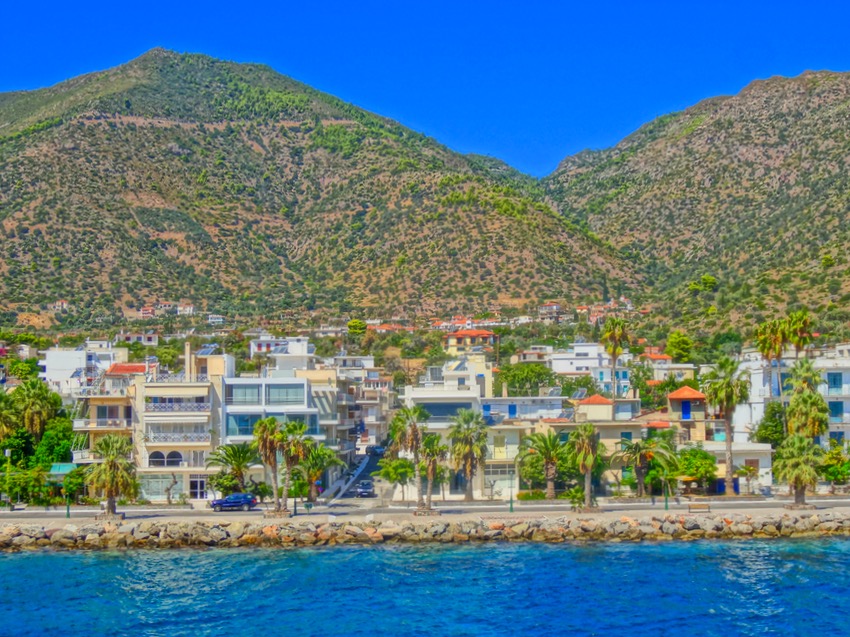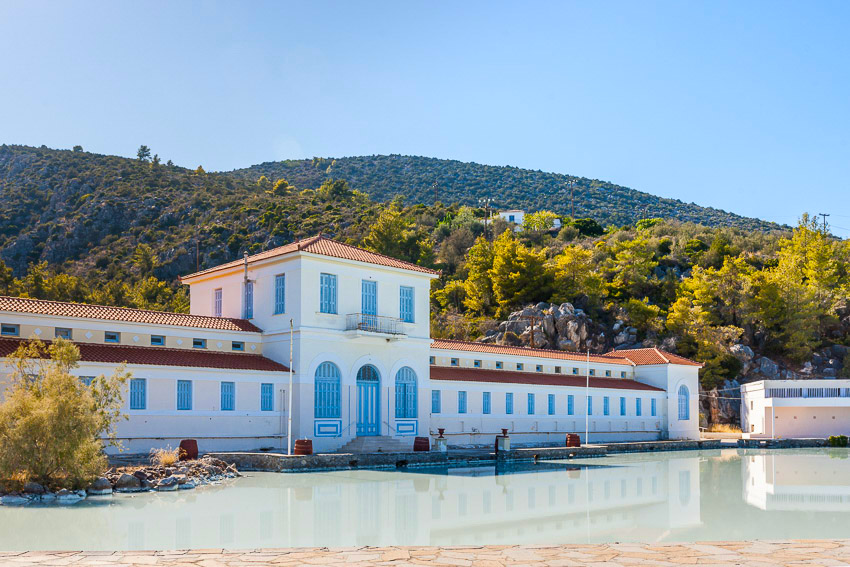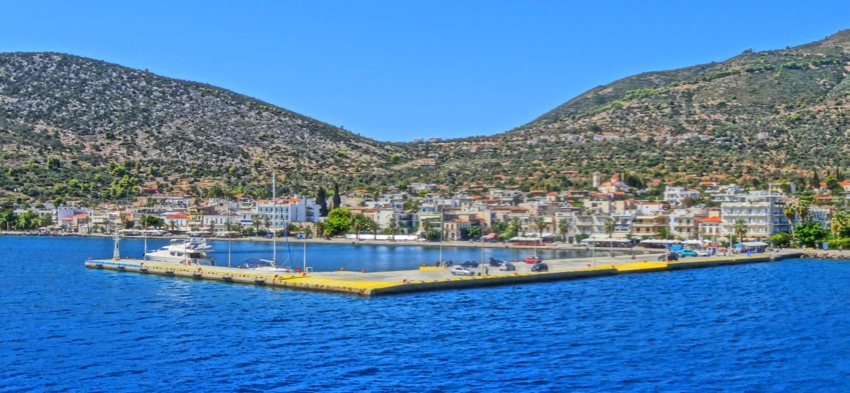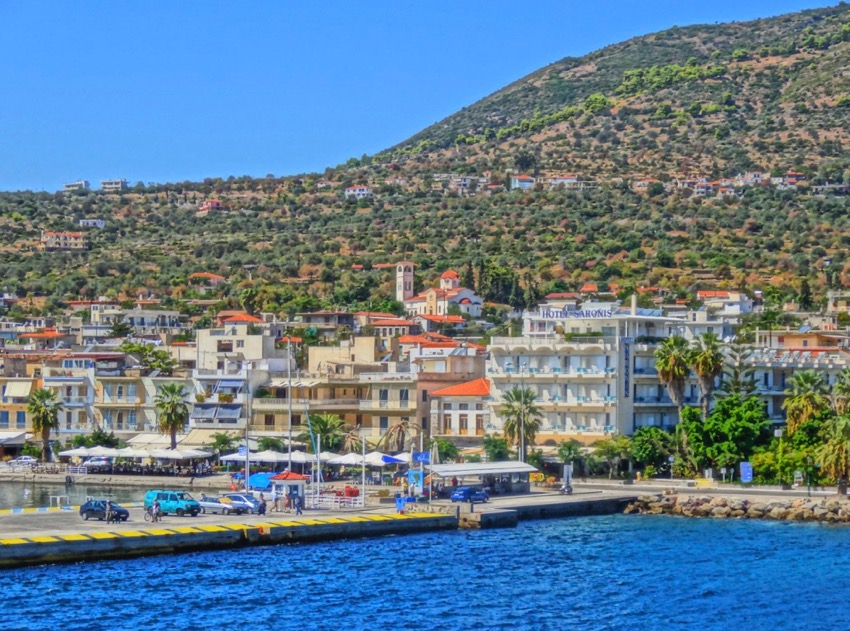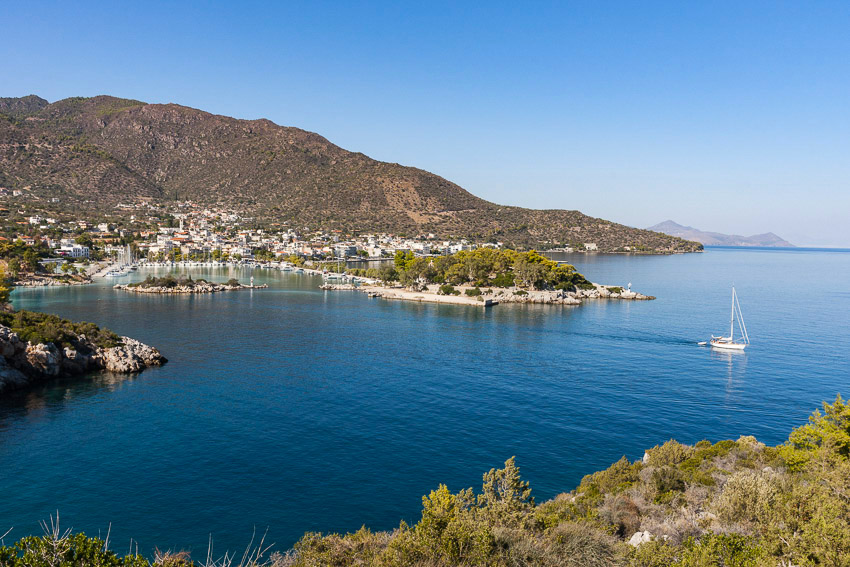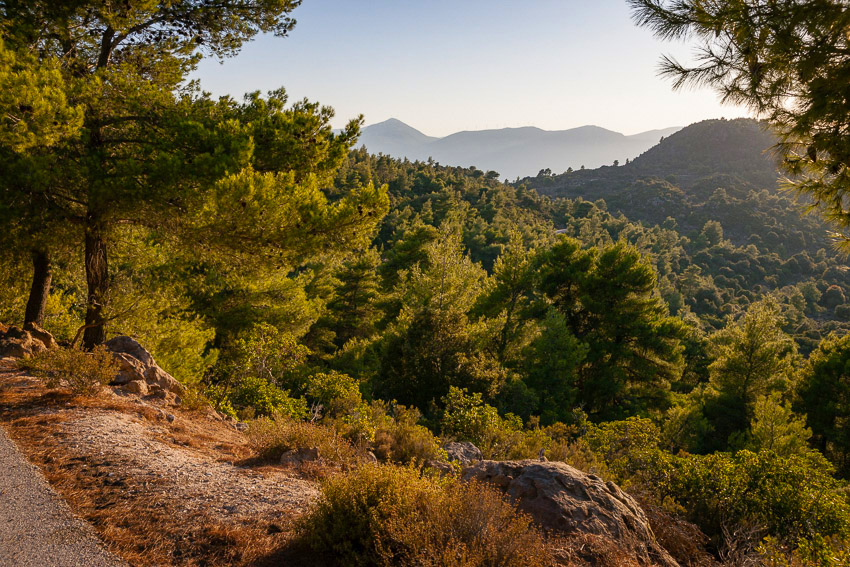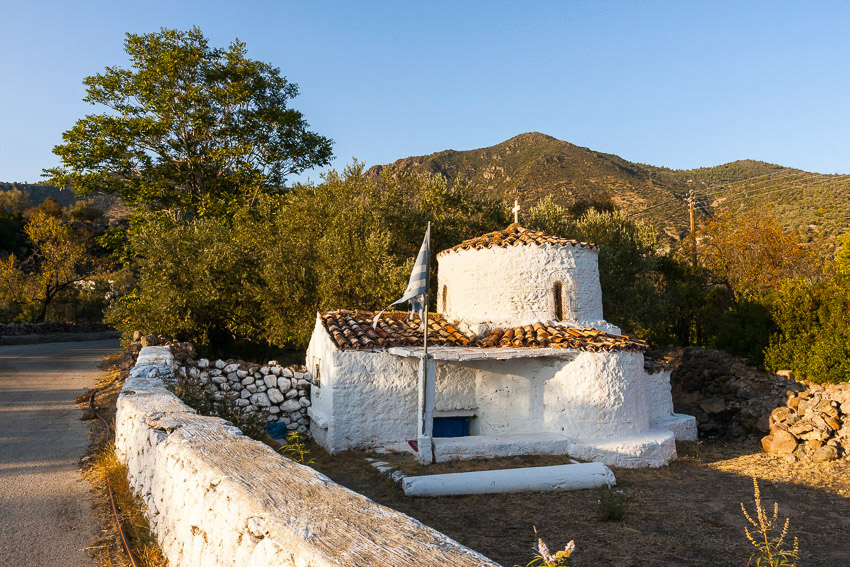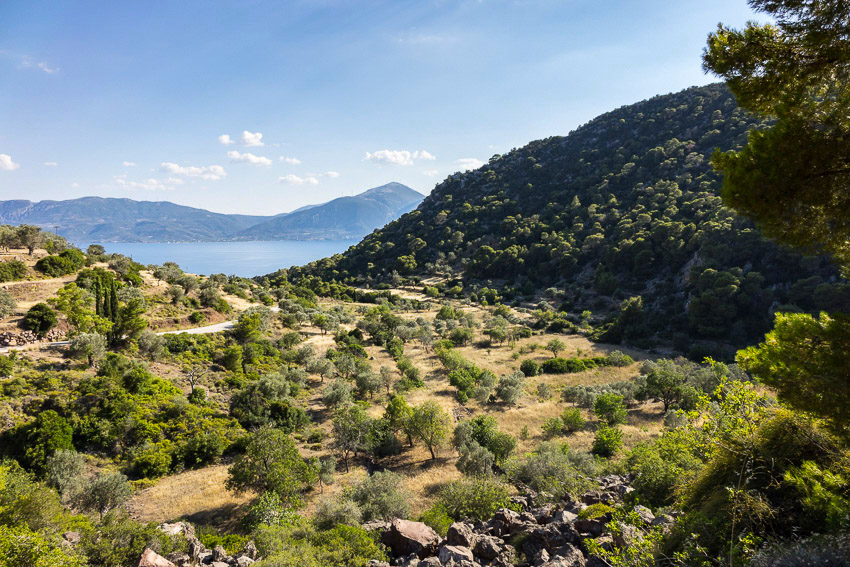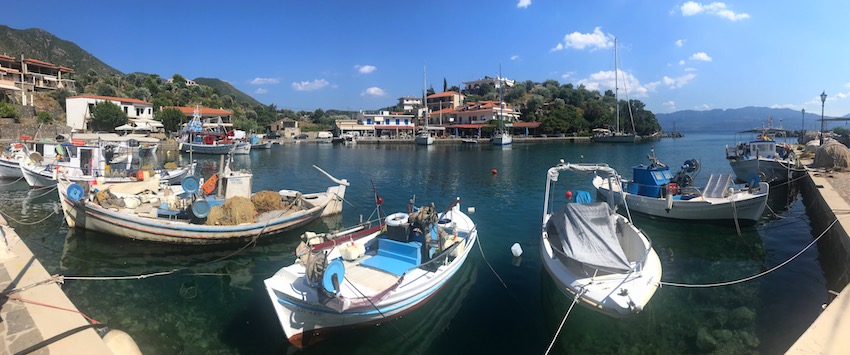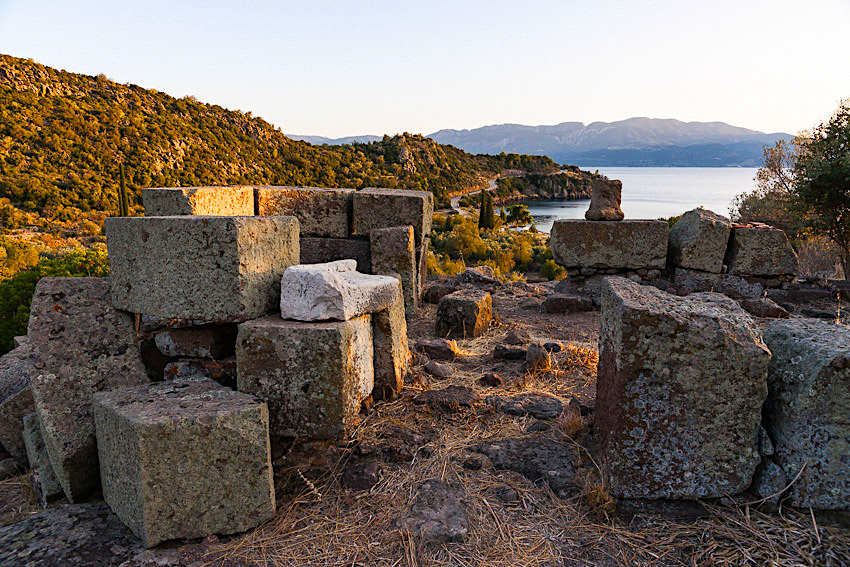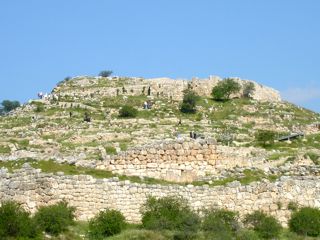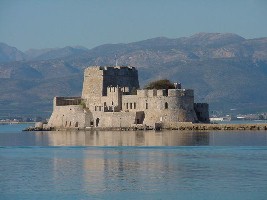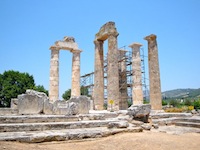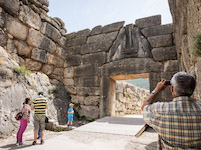
METHANA - A VISIT TO HEPHAISTOS
by Angelos Asklepiades
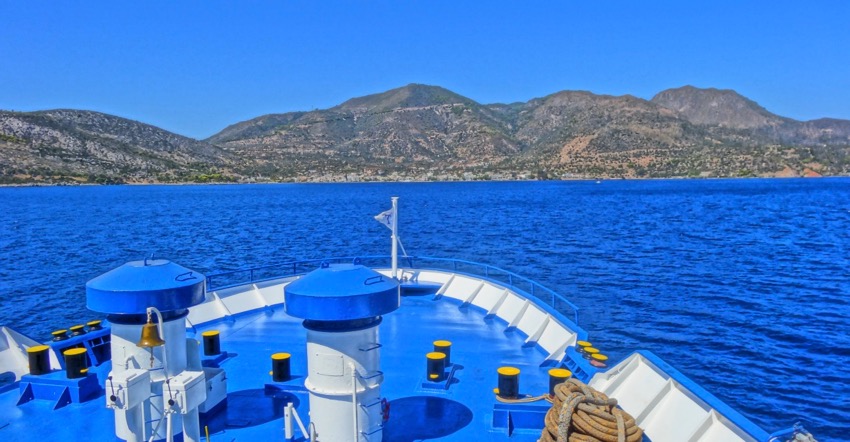
|
Sleeping Beauty The Peloponnese is full of undiscovered magic - a kind of magic that hides in out-of-time and off-the-beaten-track places such as the volcanic peninsula of Methana. With its more than 30 craters Methana is the north-westernmost of the arc of Aegean islands that still feature volcanic activity - the other islands being Milos, Santorini, and Nisyros. Just like them, Methana was born as an island a couple of million years ago but became connected to the mainland of the South-East Peloponnese by a narrow isthmus that rose up from the sea during one of the many eruptions and accompanying earthquakes. In 230 BCE a major eruption (near the present-day village of Kaimeni Chora) was recorded by several authors of the time as it was clearly seen from Athens, and as recently as 1700 CE a submarine crater erupted just off the coast of the peninsula. |
|||
|
|
|||
|
The volcanic island now sleeps the sleep of a Sleeping Beauty, allowing visitors to discover impressive lava domes and craters, age-old man-made terraces, archaeological sites, tiny fishing villages, thermal baths, and amazing views on the surrounding Saronic Gulf. Approaching it on the main road from Archaia Epidauros to Galatas we are able to admire Methana's mysterious silhouette bordering the South-Eastern part of the Gulf of Epidauros. The archaeological site of Troezen, the wetland of Psifta, the town of Galatas, and the island of Poros all lie within a stone's throw from the peninsula. Connected by ferry to Methana are the island of Aegina and the harbour of Piraeus (Athens). Even the island of Hydra is not that far away as there are ferries from and to the hamlet of Metochi on the mainland, a 40 minute drive by car. |
|||
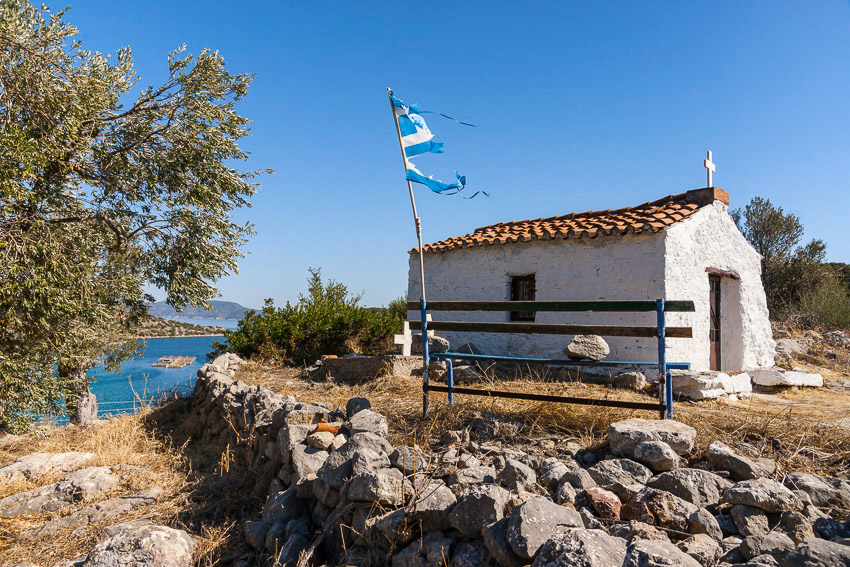 |
|||
|
Driving from the mainland onto the narrow isthmus, the ruins of towers and walls of an early 19th century castle can be seen, built by the French general Favier during the War of Independence on top of an 80 meter high hill. He made use of walls and fortifications that were constructed by the Athenian general Nikias during the Peloponnesian War at the end of the 5th century BCE when Methana and Epidauros were subject to an embargo and effectively cut off from the surrounding area by Athens as a punishment for choosing the side of Sparta during the war. A little further near to a road junction a whole section of this wall appears in between trees and bushes. Not far from the junction next to the road turning left, a hiking trail can be found that leads up to a tiny old church and continues past the ancient walls all the way to the ruins of the 19th century castle. |
|||
|
Methana, methane, and memories of the 1930s Rejoining the winding road that leads to the modern-day town of Methana offers spectacular views over the sea towards the nearby island of Poros, and about 4 kilometers further a wonderful vista welcomes the traveller to the largest town of the peninsula: Methana. The healing qualities of the thermal springs coming straight out of the volcanic craters all over the peninsula, were already known in prehistory and the first settlements date from 8,000 years ago. There are a number of Mycenaean sites as well, dating from between 1500 and 1200 BCE, and the walls and gate of an akropolis of Classical Times (4th and 3rd century BCE) can be seen near the towns of Vathi and Megalochori. Driving anti-clockwise around the peninsula of Methana by car allows the traveller to see and visit most of the archaeological sites, the spectacular lava domes and craters, and a number of tiny fishing and mountain villages where time has really stood still. Be aware, however, that GPS and mobile phone signals aren't reliable or available in every corner and crater of the peninsula. And although the main road circling the island is in perfect condition, you will need some experience driving up and down very steep slopes. It is recommendable to use a local guide in order to enjoy your tour in safety and comfort. |
|||
|
|
|||
|
To somewhat counter-balance the beautiful vista, the first thing you will notice when entering the town of Methana is the rather unpleasant smell of rotten eggs in the immediate vicinity of the open-air baths of the Thermal Spa. The typical pale-blue water contains a chemical combination of odourless methane (as Methana gave its name to this gas) and hydrogen sulfide (H2S). Apart from this bad smell the therapeutical effects of such thermal baths were appreciated since Antiquity at least, and still help people of today who suffer from arthritis, rheumatism, skin diseases, and neurological problems. This is why the neo-classical Thermal Baths of Methana were built in 1930, soon followed by a number of hotels where patients and other guests could spend the night. One of these is (or rather was) the beautiful Art Deco hotel built by Mr Zacharatos near the end of the boulevard and promenade which makes Methana humbly resemble other, much more famous holiday resorts at the Côte d'Azur. "Zacharatos Hotel" still exists in its original state but has been sadly abandoned since a decade or more. It is more than worthy of restoration and re-use, and could give Methana a much-needed boost in tourism, both therapeutical and cultural. |
|||
|
|
|||
|
Tourism in Methana still exists today, but is limited to Greeks (Athenians) and a few foreign tourists who were curious enough to venture onto the volcanic peninsula trying to stay away from much more popular, yet often crowded places like Poros, Hydra, or Spetses. They are lodged in a couple of hotels in Methana town or in guesthouses (some of which are surprisingly beautiful and classy) in or near the small villages on the coast: Agios Georgios, Agios Nikolaos and Vathi. Tranquillity, bathing, hiking, relaxing, enjoying copious meals of fresh fish, and the special feeling that you are walking and sleeping on a volcano, are the main assets of this unique place. |
|||
|
|
|||
|
A hundred meters away from the Thermal Baths in Methana town the bad smell is gone. This allows tourists to breathe again and to enjoy the peninsula of Agio Anargyroi where a small church stands on top of much older ruins, the promenade with some hotels, restaurants, and terraces, and a walk further along the bay to the church of Agios Nikolaos, where a much smaller but even older Spa can be found. Continue even further along the road near the seaside, and you find yourself on Limniona beach, usually packed during the months of July and August but otherwise rather secluded and lonely. In Methana town itself there are apart from a few hotels, restaurants, and guest houses, one or two nice supermarkets, the ubiquitous "periptera" (kiosks), a fuel pump, and a police station, but the rest of the peninsula is far more exciting than this and beckons the old-fashioned traveller to explore, walk, and be amazed. |
|||
|
|
|||
|
Mycenaean walls, terraces, and cobble stones |
|||
|
Halfway between the end of the main boulevard and the church of Agios Nikolaos, right after Hotel Athina, starts the road that will take us around the peninsula. Drive uphill and continue North-East on that road for about one kilometer and if you would like to know what remains of a Mycenaean sanctuary and village after some 2,500 years of erosion, earthquakes, and an Orthodox church being built on top of it, stop on or near an unpaved track on the left and explore. I beg you to be respectful and touch nor take anything with you from the site - it is not only a sacred place, it's of great archaeological importance and anything you might do wrong or take with you, is treated as a very serious crime in Greece. |
|||
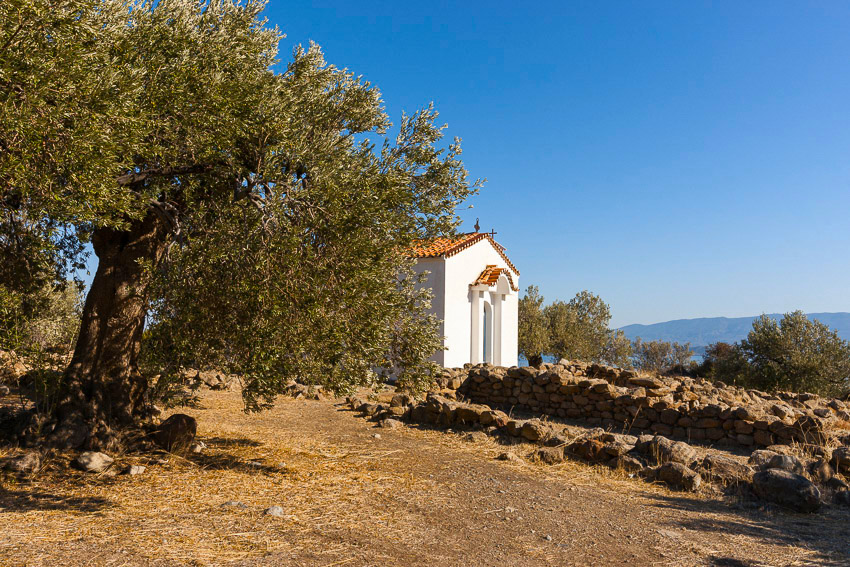 |
|||
|
After one more kilometer the road which offers some spectacular views on the Saronic Gulf, Piraeus, Athens and its riviera, and the island of Aegina, forces us to make a choice: going uphill to the left or downhill to the right. Eventually, the two roads rejoin and the choice depends on whether you prefer to continue to have views onto the sea and Aegina and visit the small fishing village of Agios Georgios where you can "admire" a concrete boat built by the Germans in WWII and now used as a small pier (no joking!), or whether you would trust me and follow my advice to take the road left, uphill, towards the mountain village of Kypseli. For now, I will abstain from writing about what Germans forgot to take with them in 1944 or how Greeks invented the concept of recycling, and instead take you to see some stone-built terraces and an age-old cobble-stone road. |
|||
|
|
|||
|
The road uphill makes a few turns and then enters a beautiful valley, where we see our first terraces. Before we reach the village of Kypseli there's an opportunity to stop and admire these man-made, stone-built structures which are to be found on almost every steep slope all over the peninsula but which nobody is able to date precisely. A lot of them are still in use today and are carefully maintained. Others are abandoned and have fallen into ruin. They could be thousands of years old, perhaps even dating back to prehistory, to a time when people changed from a nomadic lifestyle into a life of settlers, having understood how to grow crops. In any case, these terraces were built with lots of determination and lots of labour to stop landslides and erosion of the soil. They facilitate agriculture as volcanoes tend to bring up lots of minerals and other elements that make the soil on their slopes and in the valleys around them very fertile. |
|||
|
The village of Kypseli is small and we enter in a place that has been forgotten by tourism, technology, and time itself. A stop is obligatory, a walk around the place a moral duty. Climb a narrow street which is on the right when entering the village and turn right a second time almost immediately. Don't be afraid of barking dogs (they only bark and never bite) or curious looks on the faces of the locals. You're a traveller, a guest, and curious about this village. Greet the people and tell them how you like their place. Go down the narrow road which soon turns into a cobble-stone path running down the hill in between the terraces you have seen a few minutes ago. You are now walking on a road that is at least 3,500 years old. Try not to look at the plastic bottles and other garbage that has "fallen" out of the windows of the houses above you, just continue for a few minutes down the hill and find yourself surrounded by a landscape shaped by Nature, Hephaistos (the Ancient Greek deity of volcanoes), and human beings like you and me, living right here thousands of years ago. |
|||
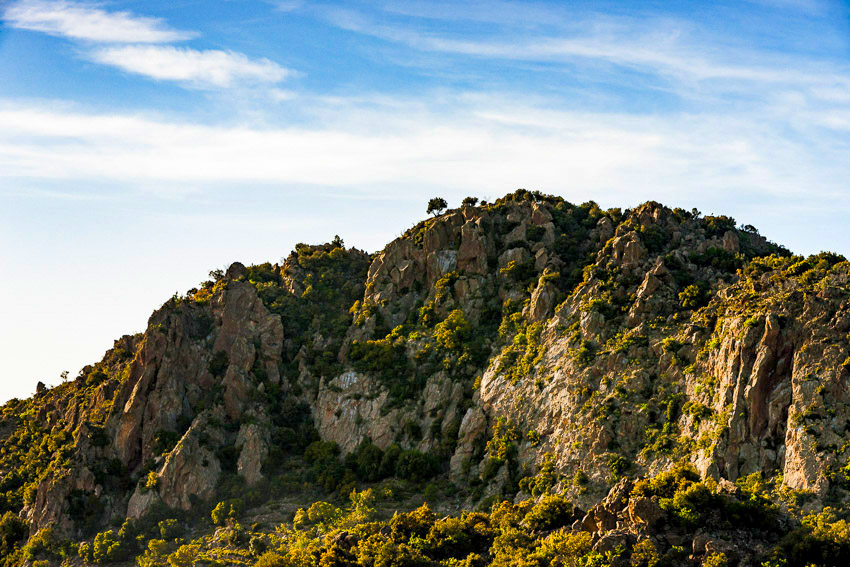 |
|||
|
If you were forgetful, didn't take a bottle or two of fresh water with you on your journey, and are now dying of thirst having gone down this road and having climbed up again to the village and your car, knock on someone's door and kindly ask for some water. Strangers will be treated as guests and "the gods visit in disguise only". There is no beach bar here, no techno music, no jet-set. There are only volcanic rocks, olive trees, stone-built terraces, flowers, laundry hanging on a line, and people who will be curious and happy to hear why you visit this forgotten place. Before you leave the village, continuing on the same road towards Agii Theodori, don't forget to look at the impressive sight of the Kossona Lava Dome, to the South-West. Behind it are the central craters of the volcano of Methana, one of which we will pass through later on our trip around the peninsula. For now we continue along the same road towards the North passing a large number of seemingly newer terraces on the slopes of the hills surrounding the valley. We drive through the village of Agii Theodori where we can stop and admire a few very old houses with old wells and threshing floors, and then continue driving along the same road North with views of the lush volcanic slopes on our left and on our right once again vistas over the sea towards Aegina. At the church of "Zoodochos Pigi" the main road turns West towards the village of Kounoupitsa. |
|||
|
Pausanias was here (and took a bath) |
|||
|
Arriving at the first house of Kounoupitsa, which is on the left side of the road, you should now leave the main road and take the smaller, yet paved, road to the right. It leads down at first, but soon climbs steeply up and makes a few sharp turns. Nothing to worry about, just drive slowly when you need to. Leaving the village of Kounoupitsa, the road gently winds down towards the sea. Arriving at a T-junction, turn left and continue following this road for just over one kilometer until you reach the next junction where you take a sharp turn right, descending to the seaside of Agios Nikolaos and the so-called "Baths of Pausanias". There is a place to park your car at the side of the road almost immediately after having taken the sharp turn to the right at the junction. Walk down the paved path, climb down some steps, and find yourself in front of a small building that hardly resembles any bath you will have seen before. When I visited it recently, the gate was closed, perhaps because the "Baths" are infamously known for having caused problems to visitors when they were breathing in noxious gases that sometimes (but rarely) escape out of the cracks in between the volcanic rocks. If you don't know the story behind the Baths (and even if you do), you might be seriously disappointed by the overall appearance of the place. What is supposed to be a bath inside the tiny building, looks far more like a water reservoir with some dark murky liquid - hardly inviting to take a bath in. Anyway, Pausanias, the famous Greek travel writer, visited Methana during his journey in the Peloponnese in the 2nd century CE and saw one or more baths or "hot springs" that had been created by the last known eruption of the volcano in 230 BCE. If this was one of them, is anybody's guess. |
|||
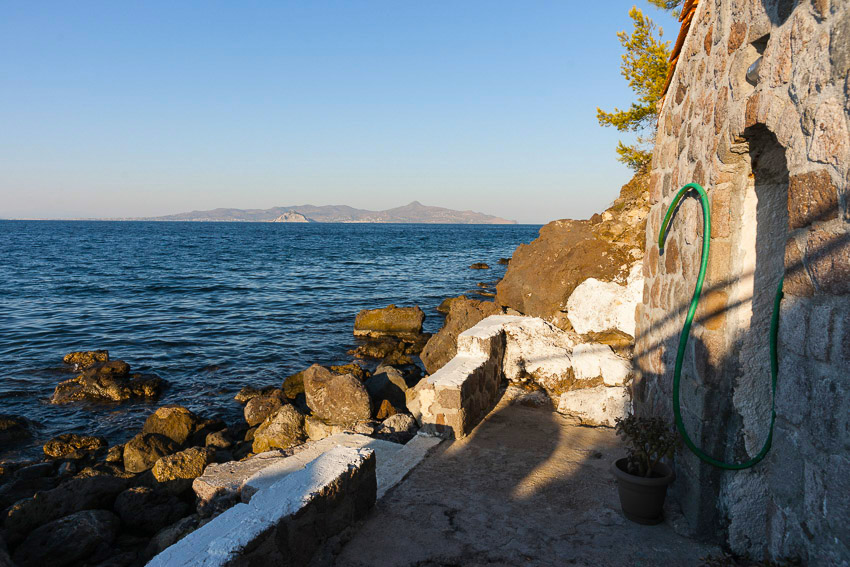 |
|||
|
Be patient - we will look upon far more beautiful and spectacular remains of that same eruption very soon. In the mean time, why not stroll along the seafront down to the thirty or so houses that make up the village of Agios Nikolaos? There are a couple of terraces that serve cool drinks and tasty meals for the tired traveller, as he will find himself in yet another out-of-time place. Small is beautiful and such is also the harbour, giving shelter from unfavourable winds to a dozen of boats at most. At the west side of the harbour we turn left and take the road that leads us past the church of Agios Nikolaos all the way up to the villages of Palaia Loutra and Makriloggos, and into one of the highest craters of Methana. Be prepared to climb all the way from sea level up to a height of 500 meters and more in less than 10 kilometers! This part of the tour is arguably the most scenic with first of all some unforgettable views over the valleys, villages, and a few of the many islands in the Saronic Gulf, and second, a drive and walk into one of the 32 volcanic craters and a spectacular descent from the plateau of the Rethi, Choni, and Malia Bgethi lava domes to the enchanting village of Kaimeni Chora. |
|||
|
|
|||
|
What goes up ... |
|||
|
After 2,5 km we reach the village of Palaia Loutra. This literally means "Old Baths" and implies there were hot springs in or around the village in a not so distant past. The village is again surrounded by terraces. We drive on and follow the road until the junction near the church of Agia Varvara where we make a sharp turn to the right and continue our ascent towards the tiny village of Makriloggos. It is worth the trouble to stop here for a few minutes, admire the vistas, and look at some of the very old houses and walls. From here there is only one way: up! Drive slowly and carefully for the first few hundred meters. The road becomes narrow for a while and makes a sharp turn left, climbing steeply onto the slopes of one of the lava domes and craters of the volcano. For a while we will be surrounded by the beauty of nature only. Don't expect a barren landscape. The slopes are full of pine trees and shrubs, and here and there we can meet a shepherd and his goats and shepherd dog. If we are lucky enough to visit Methana in Spring, upon reaching the highest point of the journey and driving into one of the 32 craters of Methana, a small piece of paradise awaits us with blossoming trees and wild flowers everywhere in a small, lush valley that once was a cauldron full of boiling lava. When we reach the other side of the crater, we can find a spot to park the car on our right hand side where the road turns 90 degrees to the left. There is a trail going down into the crater. We follow it and after 100 meters find ourselves admiring the impressive rock formations of the surrounding lava domes which are almost 700 meters high. There are a few hiking trails going all the way up there and on top of one of the domes there's even a very old church to discover, but these paths are not for the faint-hearted and require a good physical condition and serious hiking shoes. |
|||
|
|
|||
|
We continue our journey driving out of the crater and onto the very steep slopes of the Choni and Malia Bgethi lava domes. We pass the church of Agia Sotira which belongs to the now abandoned settlement of Sterna just behind it, and drive again upwards into a small valley with fields that belonged to the same small village. When we drive out of this valley, the road descends rapidly and steeply with the impressive fractured rocks of the lava dome of Malia Bgethi on our left. The views onto the tiny village of Kaimeni Chora, the sea, and the mountains of the mainland are magnificent but any driver should keep his eyes well on the road and the engine into first gear. About 200 meter after a sharp turn to the left we find space to park the car on our right and a sign that invites us to walk up to the "Hephaistion", which translates literally as the dwelling place of Hephaistos, the deity of volcanoes, but has come to signify "volcano" in general. The huge pile of boulders and fractured lava stones that rises up in front of us, is the result of the last known eruption of the volcano of Methana in 230 BCE. The northern slopes of this "historical volcano" (called historical because some authors in Antiquity described the eruption which they witnessed from a safe distance in Athens) are made of masses of dark-brown rocks, piled up on top of each other all the way down to the seashore. Let's grab our hiking shoes and walking sticks, and follow the trail that leads from the small parking over the lava stones all the way up to the top of the volcano. Just before we reach the end of the trail, our ascent is already awarded when we enter a spectacular natural arena of sharp volcanic rocks dotted with pine trees. We are not standing on solid ground but on tons of volcanic rocks that have been piled up by the eruption of the volcano more than 2,000 years ago. If we continue a little further, we find that the end of the trail leads us into a cave-like fissure lined with columns of basalt: the realm of Hephaistos. |
|||
|
Small is beautiful |
|||
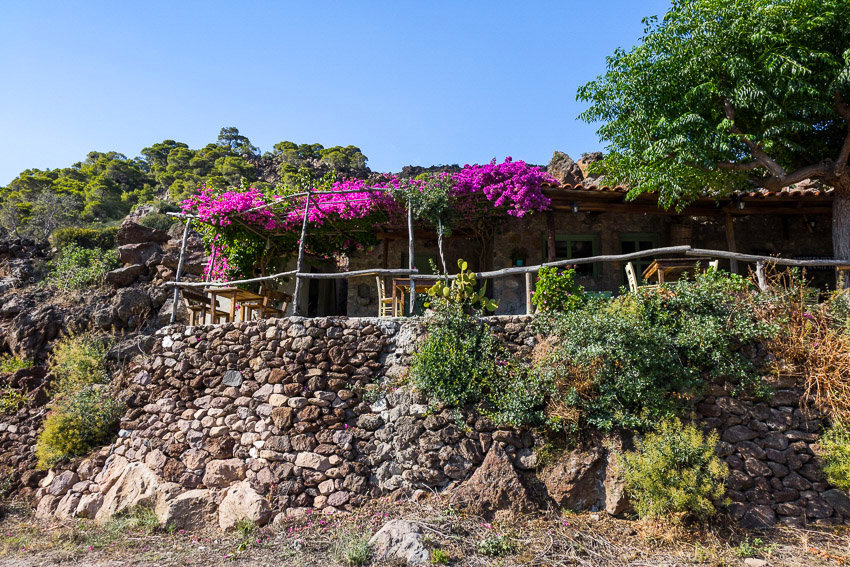 |
|||
|
From the place where we left our car it is just a 2-minute drive to the tiny, picturesque village of Kaimeni Chora, partially built on top of the slopes of the historical volcano that we've just climbed. 16 people live here, one of them a 96-year old lady who still lives happily and healthily alone in her own house. Because the village is surrounded by volcanic rocks and lava domes, there is hardly any radio or mobile network signal here - a haven for those who really want to "disconnect". Just outside the village on the right side of the road, we discover a wonderful terrace covered with grapevines and flowers. It would be a mortal sin not to stop here, have a glass of home-made wine, tsipouro, or freshly-squeezed lemon juice. The fried cheese, onion balls, tzatziki, and crispy lamb chops are fit for the Gods. But don't forget to go and have a look at the small open-air theatre that Theodoros, the owner of the place, has built a stone's throw away from his terrace. And we can follow the trail that starts next to the terrace and leads us along the other side of the volcano to a view over the Gulf of Epidauros and the "Dark Rocks". If anything defines Methana, it is this village, this terrace, this haven of tranquillity, honesty, and simplicity. |
|||
|
|
|||
|
We are now close to the end of the tour, but still have to make the circle full by driving to Vathi, the small fishing village on the south-west side of the peninsula. It has a small but very safe and very charming harbour where several yachts and a few tiny fishing boats find shelter, plus a couple of terraces with the usual choice of food and drinks. This used to be the capital of Methana in Antiquity, as the ruined walls and temple on the akropolis of "Ancient Methana" (or Paleokastro), one kilometer further along the seaside, prove us. Drive there, along the coast, visit the archaeological site, the small church of Agios Nikolaos and then turn back to enjoy the most delicious meal of fresh fish you can find at the restaurant called "Paleokastro". Sitting under a Summer's evening starry sky at a table next to the sea, enjoying a full plate of grilled sardines and a glass of white wine, I wrote this. And I wished I would never have to leave. |
|||
|
|
|||
|
Angelos Asklepiades photographs and writes about his passion: archaeological sites and their history, legends, and stories. Based in the heartland of the Mycenaean civilisation, the Argolid, he explores mythical hills and magical valleys in search of ruins and roads that were seen and described by travellers of the 18th and 19th century. A master's degree in Classical Philology and Greek Archaeology helps him to share to a general public what colleagues in history, philology, and archaeology research, excavate, and publish. You can contact him at garden.of.the.muses@gmail.com |
|||
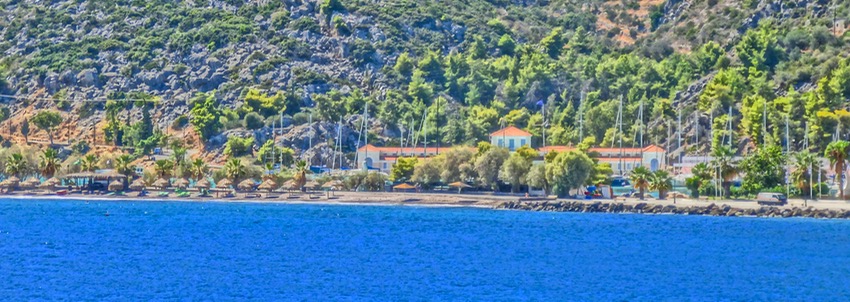 |
|||
Methana Information |
|||
|
The best way to get to and explore Methana is by car. You can drive there from Athens or take a ferry boat. Many of the ships on the Saronic Island route (Aegina, Poros, Hydra and Spetses) stop here. If you are just coming for the sea and the spa then a car is not necessary since there are beaches in the town and the thermal spa is there as well, all within easy walking distance of hotels and restaurants. You can easily visit Epidavros, Nafplion, Myceneae and other places in the northeastern Peloponnesos from Methana. You can also do it as a day trip from Athens since the ferry takes less than 2 hours. For ferry schedules see www.ferryhopper.com and for car rentals see Swift Car Rentals. Make note that the ferries are reduced and perhaps not even running in the winter months so you may want to go by car. Methana is also a nice place to stop if you are sailing the Saronic Islands. There are numerous fish tavernas and restaurants on the waterfront and as the clientele is mostly Greek the food is good. The spa is closed currently because the Greek government does not have the money to run it. However some of the hotels have spa facilities so keep that in mind. |
|||
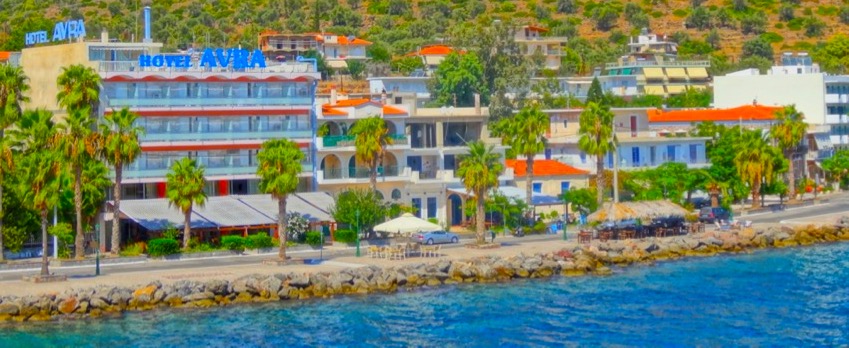 |
|||
Hotels in Methana |
|||
|
Cavos Guest House is built entirely of volcanic stone on the sea in Agios Giorgos, Methana. Besides having seaview rooms, suites and apartments they also do wellness retreats, walking and bike tours, thermal baths, private and guides tours and more. Featuring free WiFi and a garden, Apollon Hotel is located in Méthana a few steps from the beach. All units have a flat-screen TV. There is also a kitchen, equipped with an oven and refrigerator. Each unit features a private bathroom with free toiletries and a hairdryer. Saronis Hotelfeatures air-conditioned rooms with free WiFi just one minute walk from the beach. Guests can enjoy the on-site restaurant. All rooms include a flat-screen TV with satellite channels. Each room is equipped with a private bathroom equipped with a shower. For your comfort, you will find free toiletries and a hairdryer. Showcasing a sun terrace and hot spring bath, Hotel Methanion is located on the waterfront of Methana. Free WiFi is provided throughout the property and free private parking is available on site. Certain units feature a sitting area to relax in after a busy day. A terrace or balcony are featured in some rooms. Bike rental is available at this hotel. AeridesStudios offers pet-friendly accommodations and free wifi. All rooms are equipped with a TV. Enjoy a cup of tea while looking out at the sea or mountains. The rooms are equipped with a private bathroom. For your comfort, you will find free toiletries and a hairdryer. Pension Vienna features free WiFi access and free private parking.Every room at this guesthouse is air conditioned and features a TV. A terrace or balcony are featured in certain rooms. Every room comes with a private bathroom. You can find more hotels, rooms, apartments, guesthouses and villas on Booking.com's Methana Page. |
|||
|
For assistance with booking or combining Methana with your Greek Island Holiday try Matt Barrett's Greece Create-an-itinerary form or contact Fantasy Travel in Athens. |
|||
Help Support Matt's Greece Guides
Do you enjoy using my site? Have you found it entertaining as well as useful? If so please show your appreciation by booking hotels through the travel agencies and the links found on my Hotels of Greece site. The small commission I make on the bookings enable me to keep working and in most cases you won't find them any cheaper by searching elsewhere. You can find
hotels in Greece by location, price, whether or not it has a swimming pool, and see photos and reviews by using this link to booking.com which also contributes to my website when you book. If you are appreciative of all the free information you get on my websites you can also send
a donation through Paypal or Venmo
Join Matt Barrett's Greece Travel Guides Group on Facebook for comments, photos and other fun stuff. If you enjoy this website please share it with your friends on Facebook and other social media.
